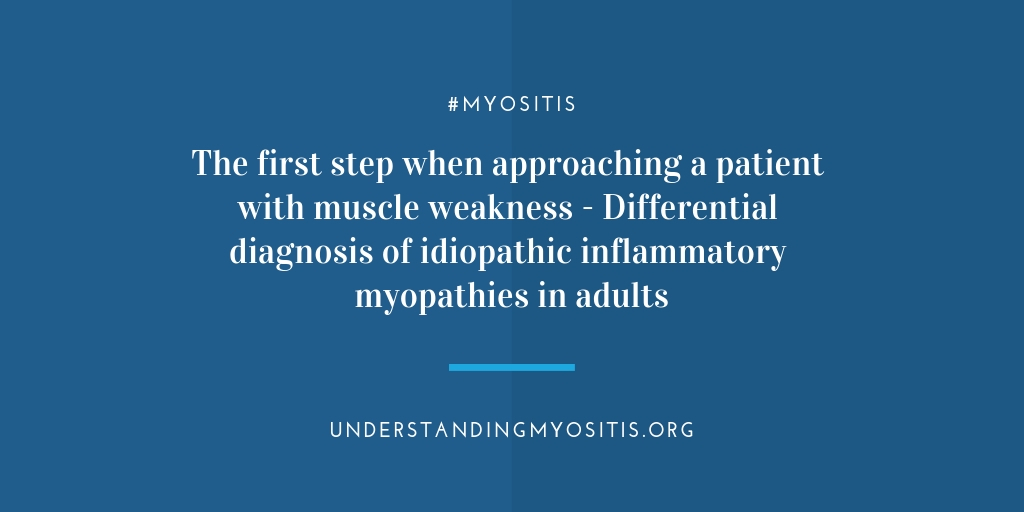In an article titled, “Differential diagnosis of idiopathic inflammatory myopathies in adults – the first step when approaching a patient with muscle weakness,” the authors present information on the differential diagnosis of adults with muscle weakness.
Differential diagnosis is the process of distinguishing a specific disease from others with similar symptoms and features. The paper points out the irony that the most commonly used diagnostic criteria for identifying the Idiopathic Inflammatory Myopathies (IIM) can be applied only after all other non-autoimmune muscle diseases have been ruled out. And there are many patients who have one of the non-IIM conditions listed in the article but were initially misdiagnosed with IIM.
The stated purpose of the article is to list the most common conditions to be differentiated from IIM. The authors selected the most common and important conditions to address and purposefully did not address certain conditions.
The authors present a summary of IIM, describing them as rare conditions with a frequency of 5.5 to 7.7 cases per million in developed countries. The diseases they included with IIM are:
- Polymyositis
- Dermatomyositis
- Sine-Dermatitis
- Inclusion Body Myositis
- Immune-Mediated Necrotizing Myopathy (IMNM) (NAM)
- Focal Autoimmune Myositis
In IIM, inflammation of various intensities and patterns affect the striated muscles due to an abnormal immune system reaction. This inflammation reduces the muscle response to signals to contract, resulting in mostly symmetric muscle weakness that can be acute, meaning very sudden, or subacute, meaning somewhat rapid. The authors point out that weakness is not the same as fatigue and diagnosis should be careful to distinguish between the two because fatigue is not a distinguishing feature of IIM, although it is a feature of many autoimmune diseases. Standard treatment for all forms of IIM is suppression of the immune system, often with glucocorticosteroids.
In the following sections of the article, the authors describe in some detail causes, symptoms and treatments for the various categories of myopathies that are not IIMs. The categories and some examples are provided in the list below:
- Toxic Myopathies
- statins (cholesterol-lowering drugs)
- stomach acid-suppressing drugs (e.g., omeprazole
- corticosteroids
- Endocrinological Causes of Myopathy
- high dose steroids
- diabetes
- excess thyroid gland hormones
- Late-Onset Muscular Dystrophies
- facioscapulohumeral muscular dystrophy
- any of 21 subtypes of limb-girdle muscular dystrophies
- Lambert-Eaton Myasthenic Syndrome
- Late-Onset Metabolic Myopathies
- glycogenosis type II (Pompe disease)
- glycogenosis type V
- neutral lipid storage disease
- Infections
- influenza
- HIV
- human T-cell lymphotropic virus type 1
- Fungal infections, e.g., Candida tropicalis
In summary, there are symptoms that occur because of diseases other than IIM that could be mistaken for IIM. For example, elevated Creatinine Kinase (CK) levels are present in 8% of patients seeking healthcare, but only .8% are found to be caused by rheumatological conditions. And 45% of patients who are referred to rheumatologists do not have IIM. There are symptoms that are reasonably reliable indicators of IIM, including:
- subacute onset
- skin lesions, for example:
- Gottron’s papules
- heliotrope rashes
- photosensitivity
- affected symmetrical, proximal (where limbs join the body) muscle groups
- Raynaud’s phenomenon
- arthritis
- interstitial lung disease
The authors also identify certain symptoms that quite possibly indicate that the disease under diagnosis is not IIM. These symptoms include:
- very slow and gradual progression or variable dynamics of symptoms
- very early onset
- family history of similar symptoms
- weakness or myalgia (muscle pain) related to exercise and fasting
- fatigue
- fasciculations (brief, spontaneous muscle contractions of a small number of fibers, often causing a flicker of movement under the skin)
- asymmetric distribution
- facial involvement
- accompanying cataract or diabetes
- severe myalgia
- highly elevated inflammation
To further complicate the process, any of the different types of myopathies may occur simultaneously, previously existing muscle disease is a risk factor for developing inflammatory myopathy. Careful diagnostic procedures, symptom identification, and muscle biopsies are critical to differential diagnosis.
—
Szczęsny, P., Świerkocka, K., and Olesińska, M. 2018. Differential diagnosis of idiopathic inflammatory myopathies in adults – the first step when approaching a patient with muscle weakness. Reumatologia, 2018; 56(5): 307–315. https://www.ncbi.nlm.nih.gov/pmc/articles/PMC6263305/
Tags: diagnosing myositis myositis research










